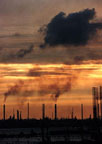Assessing Relationships between Industrial Respirable Pollutants and Excess Cancer Incidence in the Haifa Bay Region
David Broday, Yohay Carmel, Ori Eitan, Yuval, and Shai Linn1
1School of Public Health, Haifa University.
 The Israeli National Cancer Registry presented data in 2001 showing that for several cancer types, the cancer incidence rates in the years 1984-1999 in the Haifa Bay Area (HBA) were above the national average rates. Given that Haifa Bay Area is the primary industrial region in Israel and experience heavy traffic volumes, the public expressed concern whether this may be related to regional air pollution levels. This study tests whether the spatial pattern of cancer incidence in HBA can be associated with exposure of local residents to PM10emitted by nearby industry and traffic, and to SO2 which is a known marker of industrial emissions. The approach involves developing distinct metrics of integrated chronic (long term) exposure to respirable pollutants, mapping (using a GIS-based framrwork) their spatial distribution, and comparing these to the spatial pattern of the cancer incidence rates of three prevalent cancer-types (NHL, lung and bladder) in HBA, which are known to be related to exposure to air pollution in its general sense. Ward based maps of Standardized Incident Rates (SIR) and Adjusted Standardized Rates (ASR) were produced, and non-randomness tests were preformed on them to filter those that do show non-randomness in space and therefore have higher probability of showing relationships with the spatial nonrandom exposure indexes. Exposure indexes based on concentrations alone and on concentration combined with other relevant factors were produced using high-resolution concentrations maps that were created using unsupervised kriging interpolations. Our study showed no statistically significant relationships (using the Pearson’s correlation coefficient) between excess in cancer morbidity and metrics of exposure to either PM10 or to SO2.
The Israeli National Cancer Registry presented data in 2001 showing that for several cancer types, the cancer incidence rates in the years 1984-1999 in the Haifa Bay Area (HBA) were above the national average rates. Given that Haifa Bay Area is the primary industrial region in Israel and experience heavy traffic volumes, the public expressed concern whether this may be related to regional air pollution levels. This study tests whether the spatial pattern of cancer incidence in HBA can be associated with exposure of local residents to PM10emitted by nearby industry and traffic, and to SO2 which is a known marker of industrial emissions. The approach involves developing distinct metrics of integrated chronic (long term) exposure to respirable pollutants, mapping (using a GIS-based framrwork) their spatial distribution, and comparing these to the spatial pattern of the cancer incidence rates of three prevalent cancer-types (NHL, lung and bladder) in HBA, which are known to be related to exposure to air pollution in its general sense. Ward based maps of Standardized Incident Rates (SIR) and Adjusted Standardized Rates (ASR) were produced, and non-randomness tests were preformed on them to filter those that do show non-randomness in space and therefore have higher probability of showing relationships with the spatial nonrandom exposure indexes. Exposure indexes based on concentrations alone and on concentration combined with other relevant factors were produced using high-resolution concentrations maps that were created using unsupervised kriging interpolations. Our study showed no statistically significant relationships (using the Pearson’s correlation coefficient) between excess in cancer morbidity and metrics of exposure to either PM10 or to SO2.
